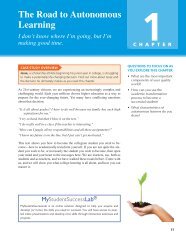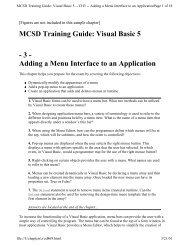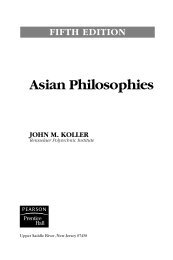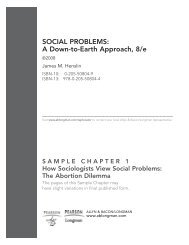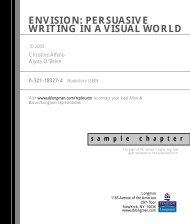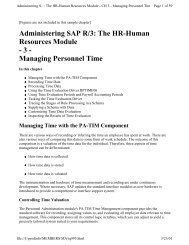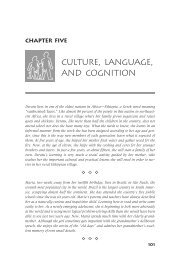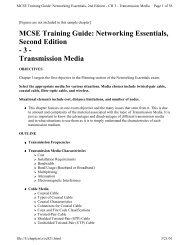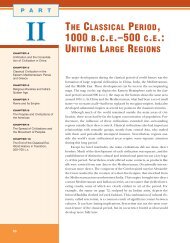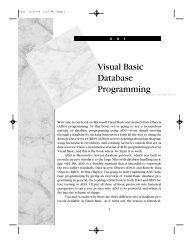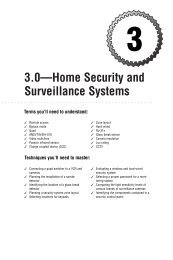Phonetic Transcription and Diacritics
Phonetic Transcription and Diacritics
Phonetic Transcription and Diacritics
Create successful ePaper yourself
Turn your PDF publications into a flip-book with our unique Google optimized e-Paper software.
54 CHAPTER 3<br />
Assessment procedures <strong>and</strong> results should be<br />
accurate, professional, <strong>and</strong> accomplished in<br />
an accountable manner. This chapter introduced<br />
the International <strong>Phonetic</strong> Alphabet<br />
(IPA) as a widely used system that can provide<br />
these requisites for the assessment of articulatory<br />
<strong>and</strong> phonological disorders. The IPA<br />
system was developed to document actual<br />
phonetic realizations of speech events. It is<br />
a means of transferring highly impermanent<br />
speech events into more durable graphic representations.<br />
Such a system offers the speechlanguage<br />
specialist a way to substantiate<br />
assessment results as well as to communicate<br />
effectively with other professionals. <strong>Transcription</strong><br />
should never be considered just an option;<br />
accurate transcription is a necessity for<br />
professional evaluations.<br />
To increase the effectiveness of the IPA system,<br />
certain diacritic markers are used to add<br />
production details to the meaning of the basic<br />
symbol. These markers are indispensable to<br />
The following transcription is from Jordan, age<br />
5;6. The fi rst transcription is broad transcription,<br />
the second one is narrow transcription.<br />
Broad <strong>Transcription</strong><br />
sit [sit] soap [so υ p]<br />
sing [siŋ] soup [sup]<br />
sock [sɑk] summer [s�m�]<br />
sun [s�n] bus [b�θ]<br />
miss [mis] toss [tɑs]<br />
goose [ɡus] race [re i s]<br />
house [ha υ s] pass [p�s]<br />
zoo [zu] zap [z�p]<br />
bees [biz] news [nuz]<br />
rose [ro υ z] trees [triz]<br />
SUMMARY<br />
CASE STUDY<br />
the documentation of many of the unusual realizations<br />
of our clients. One current diacritic<br />
system used for disordered speech, the ExtIPA,<br />
was introduced. Such diacritics were itemized,<br />
explained, <strong>and</strong> exemplifi ed in the second section<br />
of the chapter. This section also offered<br />
clinical comments on many of the diacritics<br />
as well as actual phonetic transcriptions utilizing<br />
these marks.<br />
The last section of this chapter demonstrated<br />
how phonetic transcription <strong>and</strong> the<br />
detailed knowledge acquired through its use<br />
in assessment procedures also benefi ts the intervention<br />
process. First, the accuracy needed<br />
for the transcription task promotes the fi netuning<br />
of perceptual skills, a clinical profi -<br />
ciency that will, by its very nature, enhance<br />
the likelihood of successful intervention. Second,<br />
the specifi city gained through phonetic<br />
transcription, including diacritics, translates<br />
into a far more goal-directed treatment approach,<br />
which increases clinical effi cacy.<br />
Narrow <strong>Transcription</strong><br />
sit [s�it] soap [s j o υ p]<br />
sing [s�iŋ] soup [s j up]<br />
sock [s j ɑk] summer [s j �m�]<br />
sun [s��n] bus [b�θ]<br />
miss [mis�] toss [tɑs j ]<br />
goose [ɡus j ] race [re i s�]<br />
house [ha υ s j ] pass [p�s�]<br />
zoo [z j u] zap [z��p]<br />
bees [biz�] news [nuz j ]<br />
rose [ro υ z j ] trees [triz�]<br />
What additional information do the diacritics<br />
provide? Do you see a pattern for the palatalized<br />
versus dentalized [s] <strong>and</strong> [z]?



